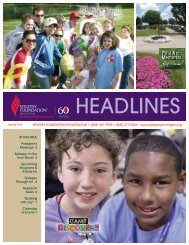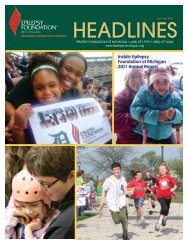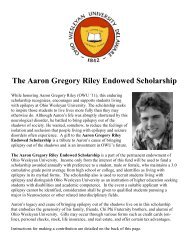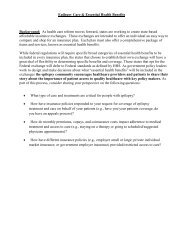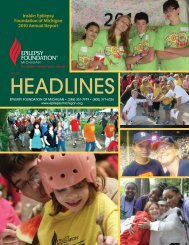Legal Rights of Children with Epilepsy in School & Child Care
Legal Rights of Children with Epilepsy in School & Child Care
Legal Rights of Children with Epilepsy in School & Child Care
You also want an ePaper? Increase the reach of your titles
YUMPU automatically turns print PDFs into web optimized ePapers that Google loves.
<strong>Legal</strong> <strong>Rights</strong> <strong>of</strong> <strong><strong>Child</strong>ren</strong> <strong>with</strong> <strong>Epilepsy</strong> <strong>in</strong> <strong>School</strong> and <strong>Child</strong> <strong>Care</strong><br />
expected course <strong>of</strong> the disorder, precipitat<strong>in</strong>g features, expected response to<br />
treatment and genetic factors.<br />
<strong>Epilepsy</strong> syndromes <strong>in</strong>clude, but are not limited to, frontal lobe epilepsy,<br />
temporal lobe epilepsy, childhood absence epilepsy, Landau-Kleffner syndrome,<br />
Benign Rolandic <strong>Epilepsy</strong>, Lennox-Gastaut syndrome, Rasmussen’s syndrome<br />
and Juvenile Myoclonic <strong>Epilepsy</strong>. 5<br />
The temporal lobes are the parts <strong>of</strong> the bra<strong>in</strong> just above the ears. People <strong>with</strong><br />
temporal lobe epilepsy most commonly have complex partial seizures <strong>with</strong><br />
automatic behaviors. Many people <strong>with</strong> temporal lobe epilepsy also have simple<br />
partial seizures dur<strong>in</strong>g which they may experience nausea or vomit<strong>in</strong>g, or<br />
feel<strong>in</strong>gs that are difficult to describe (auras). Auras may <strong>in</strong>clude halluc<strong>in</strong>ations<br />
<strong>of</strong> smells, tastes, voices, music or visual phenomena.<br />
People <strong>with</strong> frontal lobe epilepsy have partial seizures that may cause muscle<br />
weakness, thrash<strong>in</strong>g movements, or postur<strong>in</strong>g <strong>with</strong> their head jerk<strong>in</strong>g to one side<br />
while one arm lifts <strong>in</strong>to a frozen position. Frontal lobe complex partial seizures<br />
are usually less than one m<strong>in</strong>ute <strong>in</strong> length and <strong>of</strong>ten occur dur<strong>in</strong>g the night,<br />
caus<strong>in</strong>g a disruption <strong>in</strong> sleep, which can make the person sleepy dur<strong>in</strong>g the day<br />
and cause behavior problems and poor performance <strong>in</strong> school. Frontal lobe<br />
seizures can <strong>in</strong>volve scream<strong>in</strong>g, bicycl<strong>in</strong>g movements and other socially difficult<br />
behaviors. (Manag<strong>in</strong>g Students <strong>with</strong> Seizures, p. 20). In many cases, these<br />
seizures tend to cluster.<br />
<strong>Child</strong>hood absence epilepsy is also known as petit mal epilepsy and causes<br />
frequent absence seizures. It manifests itself between ages three and ten and<br />
about 40 percent <strong>of</strong> children <strong>with</strong> the condition will outgrow it or go <strong>in</strong>to<br />
remission by the time they reach their teens.<br />
Landau-Kleffner syndrome is rare. It manifests itself between ages three and<br />
seven and causes seizures and regression <strong>in</strong> speech. <strong><strong>Child</strong>ren</strong> <strong>with</strong> this syndrome<br />
have simple partial and tonic-clonic seizures.<br />
Benign Rolandic <strong>Epilepsy</strong> accounts for more than one third <strong>of</strong> the cases <strong>of</strong><br />
epilepsy that beg<strong>in</strong> <strong>in</strong> middle childhood between ages three and thirteen.<br />
Seizures occur primarily at night and are <strong>of</strong> the simple partial type, caus<strong>in</strong>g<br />
drool<strong>in</strong>g and an <strong>in</strong>ability to speak, although this may be followed by a<br />
convulsion <strong>of</strong> the body. These seizures tend to occur most <strong>of</strong>ten as the child is<br />
gett<strong>in</strong>g drowsy or attempt<strong>in</strong>g to go to sleep. <strong><strong>Child</strong>ren</strong> are otherwise normal, and<br />
95 percent <strong>of</strong> children <strong>with</strong> this condition outgrow it by age 15.<br />
5<br />
Unless otherwise noted, all <strong>in</strong>formation <strong>in</strong> this answer was obta<strong>in</strong>ed from<br />
http://www.epilepsyfoundation.org/about/types/syndromes/<strong>in</strong>dex.cfm, downloaded April 18, 2007<br />
8



